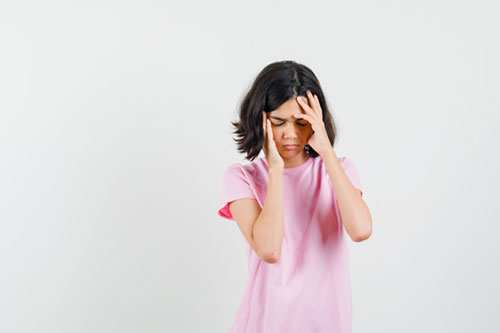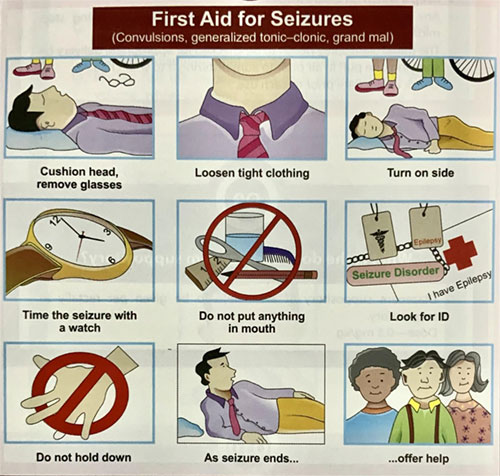Seizures (Fits) are one of the common childhood problems which primary care physicians face. Seizures are frightening and many parents who witness a first seizure fear initially that their child is dying. Some kids might have episodes of seizure like activity, but truly they are not. They are seizure mimics (jitteriness in neonates, benign myoclonus of infancy etc.)
So it’s necessary to rightly recognise a seizure and know why it occurs, and what to do when it occurs suddenly.

General symptoms of a seizure (fits):
- Brief jerky movements of arms & legs
- Blank stares and Unresponsiveness (Absence seizure common in neonates)
- Stiffening of body, Clenching of teeth
- Periods of rapid eye blinking
- Nodding head rhythmically or sudden head drop
- Repeated twitching of the face
- Falling suddenly with loss of awareness/ consciousness
Associated symptoms:
- Drooling of saliva or frothing from the mouth
- Loss of bowel & bladder control
- Sleeping or confused after the episode
Common Causes for fits in Children:
- Febrile seizures (Simple & Complex febrile Seizure)
- Meningitis/Encephalitis (Brain fever)
- Birth asphyxia (Due to brain injury at birth)
- Epilepsy disorder
- After a Head injury (bleeding in the brain)
- Metabolic/Electrolyte imbalance (low blood sugar, low calcium, low/high sodium)
- Other rare causes : Brain tumours, Hypertension induced convulsions (PRES)
Febrile Seizures:
It’s a type of seizure seen in children aged 6 months to 6 years, accompanied by fever. Your Paediatrician will rule out other causes like brain infection/injury, metabolic/electrolyte disorder, epilepsy before terming it as a febrile seizure.
Simple Febrile seizures:
- Seen between the age group of 6m – 6yrs (peak age 12-18m)
- Usually each episode lasts less than 15 mins.
- 1 episode in 24hrs (doesn’t recur within 24hrs of 1st episode)
- Involves all 4 limbs. (Never focal involving single limb or single side)
Complex Febrile Seizure: Any febrile seizure that doesn’t qualify the above-mentioned features of simple febrile seizure.
Recurrence of febrile seizure:
- 32% of children have recurrent seizures (17% have one recurrence, 9% have two recurrences, 6% have three or more recurrences)
- The recurrence rate within 1 year and 2 years of the first febrile seizure is 75% and 90%, respectively.
Risk factors for recurrent febrile seizures:
- Early onset ‹18 months of age
- Family history of febrile seizures or epilepsy in a first-degree relative
- Low-grade fever associated with seizure onset (<39oC)
- The short duration of fever before the seizure (<1 hour)
- Complex febrile seizure
As such febrile seizures are self-limiting and the overall prognosis is good. It doesn’t affect intelligence or school performance in the future.
Meningitis/Encephalitis:
- Infection (bacterial/viral) of the brain & the covering layers of the brain. Along with fever and seizure, the child might have excessive irritable crying (in infants), headache, vomiting, photophobia and altered sensorium. Sometimes Encephalitis is seasonal and can occur in unvaccinated children (Japanese Encephalitis).
- Doctors do clinical tests and lab tests like Cerebrospinal fluid (CSF) studies and Neuroimaging (CT) to confirm the diagnosis.
Epilepsy:
In epilepsy, normal brain signals get disrupted which causes multiple episodes of seizure. Causes may be genetic, Structural brain problems, Metabolic and Immune-related. In more than half of the cases, a cause cannot be found even after a detailed evaluation (EEG, MRI).
- Triggers that can cause seizures in epileptic patients: Fever, Sleep deprivation, flashing lights, Excessive screen time, Stress, and Menses in adolescent girls.
Management of Seizures
At Home:

- When you witness a seizure do not panic. Call for help. If two persons are available, one can video record the event.
- Assess the situation and move objects that may cause injury.
- Turn the child to one side (preferably the left side) and keep a watch on breathing.
- Can ask another person to arrange for an ambulance /vehicle for transport.
- Clothes around the neck must be loosened to prevent airway obstruction and put something soft under the head.
- Do not feed anything or any medicines through the mouth as the child may aspirate.
- Do not attempt to place any metallic objects in the child’s hands.
- Febrile convulsions usually settle by themselves. If not self-controlled within 3-5mins, can administer midazolam nasal spray (dosage advised by paediatrician). Try to shift the child to the nearest hospital Emergency Room.
Midazolam nasal spray:
- It is available in two forms (0.5mg spray and 1.25mg spray).
- In children 0.5mg spray is used.
- Dose is titrated as per child’s weight. A simple way to calculate is,
Patient weight x 0.2 = Number of puff to be given in each nostrils (For eg, 10kg child, 10 x 0.2 = 2 puffs in each nostrils).
| Age (years) | Weight (kg) | Dose | Puff in each nostril |
|---|---|---|---|
| ½ - 1 | upto 10 | 1.25 - 2 mg | 1 - 2 |
| 1 - 4 | 10-16 | 2 - 3 mg | 2 - 3 |
| 4 - 10 | 16-32 | 4 - 6 mg | 4 - 6 |
| > 10 | >32 | 6 - 10 mg | 10 |
Link with the video explaining how to use the nasal spray : https://youtu.be/zYo2oxYvCw

In Hospital:
- For ongoing seizures, doctors will give anti-seizure medications as injections to control the seizure.
- Simple febrile seizures: Only Basic Investigations (blood, urine) are done to know the cause of fever. Long-term medications are not needed. In some patients doctors might prescribe prophylactic medicine (clobazam) to give during fever.
- In Suspected Meningitis/Encephalitis: Lumbar puncture is done for CSF study along CT /MRI +/- Contrast. Treatment includes Antibiotics, fever control, Anti-seizure medications along with supportive medicines.
- In suspected Epilepsy: EEG, and MRI brain done. Anti-seizure medications started for epilepsy have to be continued for the long term (at least 2 years). Sometimes patients might require more than one drug. Missing medicines put the child at risk of seizure recurrence.
What to do when a child with febrile seizure history gets a fever?
- Avoid overdressing , ensure adequate hydration.
- Paracetamol should be given as per the prescribed dose for the weight.
- Tepid sponging
- Clobazam prophylaxis can be started if the doctor has advised.
Future risk of epilepsy in a child with a febrile seizure?
- Children with simple febrile seizures have 1% risk of developing epilepsy by the age of 7 years (same as the general population) and 2.4% by 25 years of age.
- The risk for developing subsequent epilepsy increases if: There is a family history of epilepsy, Complex febrile seizures, any neuro-developmental problem, or rolonged or focal febrile seizures.
Missed a dose of Anti-seizure medication, what to do?
- If it’s a once a day dosage- then take/give the medicine as soon as you remember.
- If it’s twice a day – take/give the dose if you remember within 6hrs of the due time , otherwise go for the next scheduled dose.
Precautions & Lifestyle changes needed for Child with Epilepsy:
- A child with epilepsy needs to be treated as a normal child and attend school as far as possible.
- No blanket restriction of activities should be advised.
- If seizures are not well controlled, then activities such as swimming and cycling should be under supervision.
- Teenagers with uncontrolled seizures should not be allowed to ride two-wheelers.
- Avoid video games in children with photosensitive epilepsy.
- Parents should inform teachers about the disease and medication that the child is taking.
- Teachers should know to know how to recognize seizure and basic management (positioning and giving nasal midazolam)
- Some children may have a decrease in academic performance due to medication or disease per se. They need extra attention.
- Sports like cricket, basketball and athletics have no significant additional risk and are permitted if the child is seizure free for sometime.
- Allowing for Moderate risk sports like skating, gymnastics, motorsports and cycling are decided by treating doctors on a case-by-case basis.
Overall prognosis and future of a child with epilepsy:
- Almost 60-70% will attain seizure control easily if compliant with medicines.
- Discuss with the doctor on slowly stopping the medication, if the seizure is controlled for > 2 years.
- About 30% may have difficulty with seizure control and other problems like learning difficulties, behavioural and mood problems.


